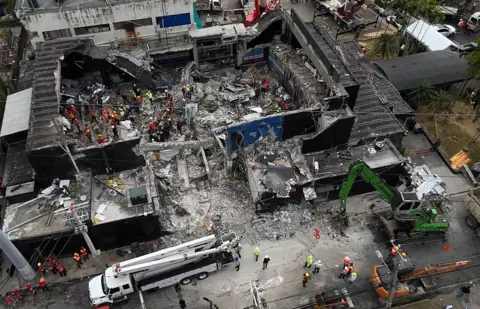Jet Set nightclub tragedy claims hundreds of lives, including high-profile figures, as investigation into structural failure begins amid international solidarity and mourning

The death toll from the catastrophic roof collapse at Santo Domingo's Jet Set nightclub has climbed to 226 as of Saturday, making it one of the deadliest structural failures in recent history. The tragedy, which struck during a packed merengue concert, has plunged the Dominican Republic into national mourning and prompted international responses as questions mount about how such a disaster could occur.
Deadly Collapse Claims Hundreds of Lives
The devastating incident unfolded shortly after 1:00 a.m. on Tuesday when the roof of the popular Jet Set nightclub suddenly gave way during a performance by renowned merengue singer Rubby Pérez, who was among those killed Yahoo News1. According to survivor accounts, the collapse began with subtle warning signs that quickly escalated into catastrophe.
"No-one thought that because a small stone fell the entire roof was going to collapse," recounted Carwin Javier Molleja, who was dancing with his mother when debris began falling from the ceiling BBC News2.
The venue was at full capacity, with local media indicating the club could accommodate between 700 and 1,000 people Reuters3. Of those present, 189 people were rescued from the rubble, while more than 200 suffered injuries. Currently, 14 people remain hospitalized, including four in critical condition Yahoo News1.
The latest fatality reported was a 41-year-old Costa Rican woman who died on Saturday despite being rescued earlier from the rubble, according to the National Health Service. Four other hospitalized victims died overnight, contributing to the rising death toll Yahoo News1.
Massive Rescue Operation and Recovery Efforts
The collapse triggered one of the largest emergency responses in the country's history. More than 4,500 emergency workers were deployed to the scene, working for nearly 59 hours in search and rescue operations Reuters3.
"This is the hardest task I've had in my 20 years of leading the COE," said Emergency Operations Center chief Juan Manuel Mendez, underscoring the unprecedented scale of the disaster Reuters3.
The chaotic aftermath was described by survivors as a scene of panic and desperate attempts to help those trapped. "People were going crazy. They were pulling out injured people. I saw when they pulled out the saxophonist who died," recounted Carwin Javier Molleja BBC News2.
Identification of victims has been particularly challenging, according to Health Minister Victor Attalah, who explained that most victims required biometric matching due to the nature of their injuries. "There had been a delay in identifying victims because the majority of them had to be matched using biometric data," he told journalists Yahoo News1.
As of Saturday, authorities confirmed that 225 bodies had been returned to their families, allowing the grieving process to begin for many Yahoo News1.
High-Profile Victims and International Impact
The collapse claimed the lives of several notable figures beyond singer Rubby Pérez. Politicians, athletes, and a fashion designer were among those enjoying the live music when disaster struck Yahoo News1. Reports indicate that 17 U.S. citizens were among those who perished CNN4.
The international impact of the tragedy was evident as New York City lowered flags at City Hall and other city-owned buildings in solidarity with the victims. Mayor Eric Adams announced plans to travel to the Dominican Republic on Sunday with NYC Transportation Commissioner Ydanis Rodriguez, who is Dominican, to pay respects NY Post5.
On Thursday, President Luis Abinader and First Lady Raquel Arbaje attended the burial of singer Rubby Pérez at Santo Domingo's National Theater, honoring the performer who had been on stage when the disaster occurred Yahoo News1.
Investigation into Structural Failure Begins
While the Dominican government released an official report on Friday detailing the emergency response, the cause of the catastrophic collapse remains unclear. "The report did not clarify the causes of the tragedy," Reuters noted, adding that "a team of national and international experts is expected to continue investigating the structural failure" Reuters3.
Eyewitness accounts suggest that there may have been warning signs before the main collapse. Carwin Javier Molleja's observation of small debris falling from the ceiling moments before the main collapse indicates a potential progressive failure mechanism BBC News2.
The New York Times reported that video evidence shows debris was already falling from the ceiling before the complete cave-in occurred, suggesting the potential for structural problems that might have been detectable in advance New York Times6.
Questions about building code compliance and structural inspections are likely to become central to the investigation as it progresses. The International Nightlife Association (INA) expressed condolences while highlighting the importance of safety standards in nightlife venues globally International Nightlife Association7.
National Mourning and Future Implications
The Dominican Republic has entered a period of national mourning, with President Luis Abinader scheduled to attend a memorial mass at the Polideportivo De Haina sports center this Sunday, marking the final day of the official mourning period Reuters3.
The scale of this tragedy is likely to prompt significant reviews of building safety regulations and enforcement mechanisms across the Dominican Republic and potentially throughout the region. The involvement of international experts in the investigation suggests recognition of the need for comprehensive analysis and potentially updated safety protocols.
For survivors like Carwin Javier Molleja, the psychological impact remains profound. "What I have in my head are the screams, the loud sound of the ceiling falling in, my mum's screams asking me if I'm OK, me asking her if she's OK," he recalled, capturing the traumatic experience that will likely require long-term support for those affected BBC News2.
As the Dominican Republic begins to process this national tragedy, questions linger about how such a catastrophic failure could occur in a popular venue and what steps will be taken to prevent similar disasters in the future. Will this devastating event lead to meaningful reforms in building safety standards, or will it become another painful reminder of the consequences when structural integrity is compromised?

